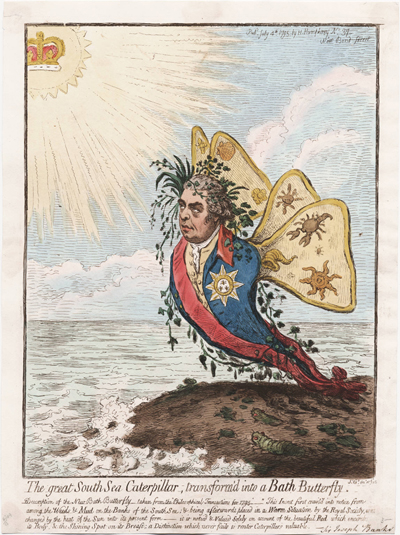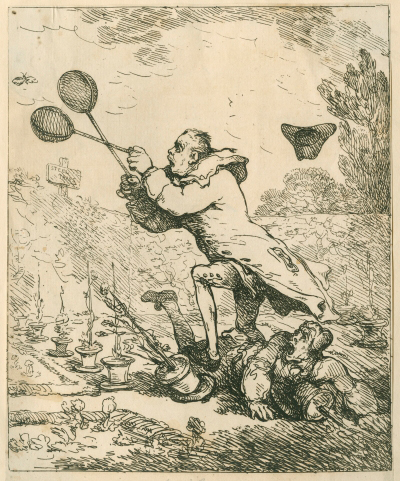The Great South Sea Caterpillar Transform'd into a Bath Butterfly
One of the most reliable techniques of satiric caricature is the portrayal of people as objects or animals, creating a visual metaphor suggesting that a person is not only LIKE an object or animal, but IS that thing.
One of Gillray's earliest and most famous uses of the technique satirized William Pitt as An Excrescence, a Fungus, alias a Toad-Stool upon a Dung Hill (1791). But we also find Charles James Fox pictured as a rattlesnake in The Republican Rattle-Snake Fascinating the Bedford-Squirrel (1795), Thomas Taylor as a collection of apothecary implements in Democratic Leveling. . . (1796), and Lord Nelson as an ornate vase in From Sir Wllm Hamilton's Collection (1801).

© Lewis Walpole Library, Yale University
This satiric portrait of the naturalist and botanist Sir Joseph Banks was prompted by Banks's investiture as a Knight of the prestigious Order of the Bath on July 1st, 1795, a few days before its publication. It portrays Banks, dripping with plants and seaweed, as a lowly caterpillar emerging under the warm sun of royal favor from the mud and weeds of a south sea island to become a gaudy butterfly. His wings are decorated with the types of shells, insects, crabs, and other specimens that Banks would have gathered on his expedition with Captain Cook to the south seas. Across his chest, the red riband and star that signifies a Knight of the Order of the Bath are prominently displayed. But within the star, Gillray has replaced the three crowns that are part of the insignia with three insects. The wonderful parody caption purports to be a botanical "Description of this New Bath Butterfly" taken from the "Philosophical Transactions" of the Royal Society.
This Insect first crawl'd into notice from | among the Weeds & Mud on the Banks of the South Sea; & being afterwards placed in a Warm Situation by the Royal Society, was | changed by the heat of the Sun into its present form—it is notic'd & Valued Solely on account of the beautiful Red which encircles | its Body, & the Shining Spot on its Breast; a Distinction which never fails to render Caterpillars valuable.
The son of a wealthy gentleman, Sir Joseph Banks had developed an early and intense interest in botany at Eton, fascinated by the local wildflowers. At Oxford, he personally hired and funded a botanist and mathematician from Cambridge, when he discovered that the Oxford Professsor of Botany did not lecture. And then when he learned of the opportunity to do hands-on research on an expedition to Labrador and Newfoundland, he left Oxford without a degree to study the flora and fauna of those countries, gathering and documenting an extensive collection of specimens.
But it was as the principal botanist on Captain Cook's first voyage of scientific discovery to the south seas (1769-1771) that Bankes really made a name for himself. On his return, he was caricatured by Mathew Darly as The Botanic Macaroni (1772), satirized (with Asses ears) in The Fly Catching Macaroni (1772), and celebrated by Joshua Reynolds and Banjamin West in handsome half and full-length portraits respectively (~1773)
His immense energy and singular focus in the collection of specimens of flora and fauna throughout the world led to his election as a fellow of the Royal Society in 1766. His ability to organize people and resources for further research expeditions and his gift for making the right contacts—both scientific and financial— eventually led to the "Warm Situation" referenced in Gillray's caption—President of the Royal Society (1778). It was a position he was to hold for over forty years.
But he was not without his critics. Beginning with The Fly Catching Macaroni (1772) and continuing with A Country Pursuit, part of Peter Pindar's verse satire Sir Joseph Banks and the Emperor of Morocco (1788), and even later, The Naturalist's Visit to the Florist (1798), Bankes was caricatured as obsessive in his devotion to collecting speciments and oblivious to all else. Similarly, within the Royal Society his critics believed he emphasized botanical and natural science at the expense of mathematics and the other sciences such as physics and chemistry.

A Country Pursuit [1788]
© The Royal Society
Gillray's satire picks up on another strand of criticism made by Peter Pindar in Peter's Prophecy; or The President and Poet; or, an Important Epistle to Sir J. Banks... (1788): that Banks was a flatterer who cozied up to the King and other influential patrons, and reaped the benefits of his efforts including a baronetcy in 1781 and the ultimate honor, a Knighthood in the Order of the Bath which was usually reserved for military, naval, or diplomatic service. However fair or unfair the charge I can't help but think that in choosing to portray Banks as a caterpillar emerging as a butterfly Gillray is remembering the ultimate Shakespearian flatterers—"Bushy, Bagot, and their complices" in King Richard II, Act II, Scene 3 whom Bolingbroke famously describes as "caterpillars of the commonwealth."
Sources and Reading
- Commentary from the British Museum on The Great South Sea Caterpillar Transform'd into a Bath Butterfly.
- Draper Hill, Fashionable Contrasts, 1966, #69
- "Joseph Banks," Wikipedia
- "Banks, Sir Joseph (1743–1820)" Australian Dictionary of Biography
- Thomas Wright and R.H. Evans, Historical and Descriptive Account of the Caricatures of James Gillray #410.
- Thomas Wright and Joseph Grego, The Works of James Gillray, the Caricaturist; With the History of His Life and Times p. 198.
Comments & Corrections
NOTE: Comments and/or corrections are always appreciated. To make that easier, I have included a form below that you can use. I promise never to share any of the info provided without your express permission.